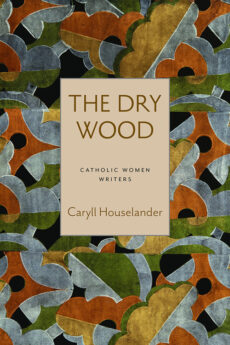In ‘The Dry Wood,’ Houselander explores the mystery of Christ’s life in us

Reviewed by Lindsey Weishar
Though certainly not a new book, mid-20th century spiritual writer Caryll Houselander’s “The Dry Wood” has something to say to 21st-century readers. Houselander’s only novel, originally published in 1947, has recently been re-released by The Catholic University of America Press as a part of its Catholic Women Writers Series.
The novel takes as its main focal points the death of a saintly priest, Father Malone, and the dying child Willie Jewel, for whom the parishioners of Riverside are praying a novena for a miracle through Father Malone’s intercession.
Houselander’s novel-writing style is, in the words of Julia Meszaros — one of the editors of the Catholic Women Writers Series — “innovative.” During a seminar I took in March on “The Dry Wood,” I learned from Meszaros that on the one hand, the novel has elements of the modernist literary style, like chapters dedicated to different characters and their perspectives.
On the other hand, Houselander departs from modernist writers in her concern with taking readers beyond these characters’ limited perspectives and creating a world which is steeped not only in the natural, but the supernatural. At the forefront is the deep conviction that Christ lives in every person, that every person has cosmic significance. And perhaps boldly, Houselander presents suffering as a key way to imitate Christ.
In chapters that follow various characters from Riverside, we learn about their sufferings: Rose O’Shane, who struggles with alcoholism but tries to offer up this struggle for Willie Jewell; Francisco Fernandez, whose daughter ran off with a man due to her harsh upbringing; and Timothy Green, who converts to Catholicism but feels extraordinarily lonely in it.
UNDERSTANDS HUMAN CONDITION
Over and over again, I’m amazed by how well Houselander seems to understand the human condition. For example, in one scene, she describes the desire of Father O’Grady, the priest who steps into Father Malone’s shoes after his death, to pray well, despite the many duties that make it difficult. He tries to pray from midnight to 1 a.m. each morning, hoping it will allow him to “gather himself together into one whole, complete act of adoration” because “nothing in the daytime ever seemed complete,” shot through as it is by distraction and interruption.
At the forefront is the deep conviction that Christ lives in every person, that every person has cosmic significance. And perhaps boldly, Houselander presents suffering as a key way to imitate Christ.
The novel’s concern with human suffering extends even to characters that readers might dismiss or disdain. For example, one of the minor characters, Peter, is a Communist leader of a group of young adults. Of him Houselander says, “He did not recognize who it was that he sought, but the drag was there at his heart in unappeasable, gnawing compassion.” Though in some ways he is ideologically opposed to the Catholic characters, his concern for the poor, the suffering, and the humiliated is something that unites him to the Christ he does not recognize but through his actions still seeks.
REDEMPTIVE SUFFERING
The novel does not shy away from redemptive suffering, and even approaches the idea of the suffering of innocents in the person of Willie Jewel. Like a little Christ, his sick body unites all who are praying the novena; his life pulls many of these characters out of themselves and invites them to enter more deeply into what it means to be part of the Body of Christ. And this Body of Christ extends outward into the world so that everything and everyone, viewed through the lens of this “Universal Mother,” are steeped in the life, passion, death, and resurrection of Christ.
As I read “The Dry Wood,” I heard the poetry that marks Houselander’s nonfiction works, like “The Reed of God.” Sometimes she seems to depart from the plot to enter into a meditation, but more often she is able to intertwine her conviction that Christ lives in every person into the conversation being had among characters.
As a reader of today, I sometimes felt myself thinking that Houselander could be more subtle in parts of the novel, especially in the expression of religious belief among the characters, but I enjoyed how she challenged me to revise my tendency to minimize or hide my faith in certain situations, and to better recognize that Christ lives in each person. Consider adding this book to your Holy Week reading list — it’s certainly worth the read.
A special thank you to The Collegium Institute Global Catholic Literature Seminar on Caryll Houselander’s “The Dry Wood,” and to Julia Meszaros, whose scholarship and presentation on this novel informed this book review.
—
 LINDSEY WEISHAR is a poet, freelance writer, and native of Champaign who has a master of fine arts in creative writing from the University of Missouri-Kansas City. She is executive assistant to the president of Donnelly College in Kansas City, Kansas. Write to her at lweisharwriting@gmail.com.
LINDSEY WEISHAR is a poet, freelance writer, and native of Champaign who has a master of fine arts in creative writing from the University of Missouri-Kansas City. She is executive assistant to the president of Donnelly College in Kansas City, Kansas. Write to her at lweisharwriting@gmail.com.





